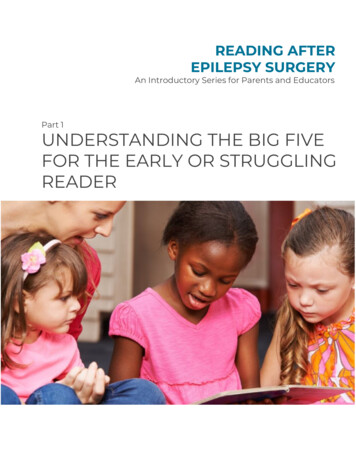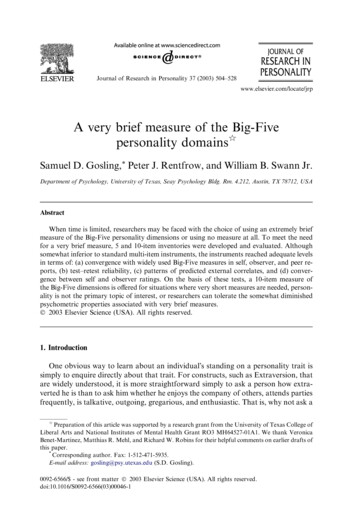
Transcription
READING AFTEREPILEPSY SURGERYAn Introductory Series for Parents and EducatorsPart 1UNDERSTANDING THE BIG FIVEFOR THE EARLY OR STRUGGLINGREADER
INTRODUCTIONIn today’s world, r eading is the key to independence . Reading entertains you when you’re bored,keeps you company when you’re lonely, and opens up a world of knowledge when you’re curious.Through the teen years and into adulthood, reading connects you to friends and family as you textback and forth, helps you order your favorite meal from a menu, and gets you on the right bus onyour way to an appointment. Reading makes it possible to have a job, understand the leaseagreement for your new apartment, and follow directions on a bottle of prescription medication.It’s clear that reading touches nearly every aspect of our daily lives and is arguably t he mostimportant skill your child will need in their lifetime. Children who have reading difficulties have ahigher school dropout rate, are at greater risk of unemployment, achieve lower income levels inadulthood, and struggle with feelings of low self-esteem and adjustment.1 This is why it’s soimportant for a child to learn how to read. Unlike learning how to walk or talk, reading doesn't comenaturally to children – it must be taught!Unfortunately, children with epilepsy have a much higher rate of reading difficulties w hen2compared to the general population. If the epilepsy is drug resistant, the seizures interfere withknowledge and skill acquisition.Epilepsy surgery can also negatively impact a child’s reading development in many ways. Becausereading involves several different areas of the brain working together, removing or disconnectingparts of the brain can contribute to poor reading development. For example, children who have hadthe occipital lobe removed or disconnected (such as after hemispherectomy, temporal loberesection, or posterior quadrantic resection also known as “TPO”) will have vision challenges thatmake it difficult to see a whole world. Removing a temporal lobe results in auditory challengeswhich can make it difficult to figure out the sounds letters make. Intellectual impairments ormemory deficits can also making reading difficult.In this guide, we will review the basics of reading to help you understand what’s important.Subsequent guides in this series will discuss how the basics of reading relate to a child who has hadepilepsy surgery, the unique obstacles they face on the road to reading, and how to make a plan toovercome them. Starting early, with proper assessment, intervention, and a thoroughunderstanding of the obstacles to reading, most children after epilepsy surgery have a chance tobecome literate.1Patil M, Saraswathi G, Padakannaya P. Self-esteem and Adjustment among Children with Reading and Writing Difficulties.Stud Home Comm Sci 2009; 3(2): 91-95 Fastenau PS, Jianzhao S, Dunn DW, Austin JK. Academic underachievement among children with epilepsy: proportionexceeding psychometric criteria for learning disability and associated risk factors. J Learn Disabil 2008;41: 195–207.2READING AFTER EPILEPSY SURGERYAn Introductory Series for Parents and Educators1
THE BASICS OF READINGWhile our brains are naturally wired for spoken language, reading is not a natural process likewalking or talking. R eading must be taught explicitly and formally in order to be acquired.3 This isbecause reading is a relatively new development in human history – in fact, it is only in the lasthundred years that a majority of the world’s population could be called literate.Reading is a complicated process, involving our vision, hearing, and several areas of our brainworking together quickly to make sense of written words. While different regions of the brain dohave specialized functions, it’s important to remember that the brain is really a complicated networkof pathways involving the eyes, ears, and both sides of the brain. If disrupted, these broken pathwayscan lead to reading challenges.The Big Five Of ReadingReading is broken down into five main areas: p honemic awareness , p honics , f luency , v ocabulary ,and comprehension . According to the National Reading Panel4, it’s important to understand thesedifferent parts of reading and how they work together.Here, we’ll use the word “shop” to explain the five main components of reading.3Gabrieli, J., C hristodoulou J, O’Loughlin, T, Eddy, M. (2010) "The Reading Brain” In: Mind, Brain, and Education. 1st Ed.Bloomington: Solution Tree Press; p. 113. National Reading Panel (U.S.), & National Institute of Child Health and Human Development (U.S.). (2000). R eport of theNational Reading Panel: Teaching children to read : an evidence-based assessment of the scientific research literature onreading and its implications for reading instruction : reports of the subgroups . Washington, D.C.: National Institute of ChildHealth and Human Development, National Institutes of Health.4READING AFTER EPILEPSY SURGERYAn Introductory Series for Parents and Educators2
Phonemic awarenessWhile we use our eyes to read, the true starting point f or reading is sound . The child must learn toconnect what she hears and says to the written letter on the page. This ability to notice, think about,and work with the individual s ounds in words is called p honemic awareness . It’s the knowledgethat s ounds of spoken language make words .Phonemic awareness is 1 00% auditory , meaning it is only related to the sounds a letter makes, orthe sounds letters make together in a word. Phonemic awareness has nothing to do with writtenletters or words.According to the National Reading Panel, teaching phonemic awareness to children significantlyimproves their reading. For this reason, it’s critical that a child learning to read receives e xplicit andsystematic phonemic awareness instruction .Phonemes - The Sounds of LanguageAp honeme is an individual sound in a spoken word. For example, the word “stop” has fourphonemes: /s/ /t/ /o/ /p/; “shop” has three phonemes: /sh/ /o/ /p/. While English has 26 letters, it hasabout 44 phonemes! These are unique, individual sounds we put together to form spoken words.Children learning how to read may find this chart helpful when learning the different sounds in theEnglish language:There are many activities you can use to help your child learn phonemic awareness. These include: matching spoken words by initial sounds (“ shop and s hare both start with / sh /”)separating the sounds in a word (sh-o-p)blending separate sounds into a word (“I say sh-o-p, what word is that?”)READING AFTER EPILEPSY SURGERYAn Introductory Series for Parents and Educators3
changing the phonemes in a word (“say stop without the / s /”)Note that all of these are about s poken language. Parents, therapists and teachers developchildren’s phonemic awareness through songs, nursery rhymes, poems, reading aloud and, ingeneral, exposing them to as much spoken language as possible.The Steps to Phonemic Awareness - Phonological AwarenessPhonological awareness can be described as a series of steps a child takes b efore they reach theultimate goal of phonemic awareness. These steps often overlap. Here’s an example:When first learning the sounds of language, a child typically starts by understanding the differentsounds in rhymes, word play, and alliteration (when the same sound occurs at the beginning of or inclosely connected words). Alliterations like: “She sells seashells by the seashore” or “Peter Piperpicked a peck of pickled peppers” and other silly poems or songs help children with this first step.The child will then start to blend and segment sentences – he may say “put ball in box” and “Momhelp” when he means “Mom, help me put the ball in the box.” In kindergarten, the child will start tolearn how to blend and segment syllables. Exercises like clapping for each syllable in a word arecommon kindergarten games. Children will then learn how to blend and segment onsets (the firstsound of the word, like “c” in “cat”) and rime (the string of letters that follow the first sound, like “at”after “c” in “cat”).The last step is blending and segmenting phonemes - the individual sounds in a word . This isphonemic awareness . Games and exercises like: What sound do these words begin with? boy, box, bike;What is the middle sound in the word sack?What word am I saying - “t” . “a” . “p”’;How many sounds are in the word shop?What will I have if I change the “r”in rug to “m”?PhonicsPhonics is the relationship between, and the explicit instruction of, written letters/lettercombinations to spoken sounds. Phonics puts together the sounds you hear (called p honemes )with a written symbol (called graphemes ). In English, letters are graphemes.Phonics also includes an understanding that there is a predictable relationship between thesounds of spoken language, and the letter patterns that represent those sounds in written language(knowing the /sh/ sounds is represented by the two letters -s-h-). This includes d ecoding , commonlyknown as “ sounding out words .”When your child’s teacher talks about phonics you might hear terms like: Short and long vowel sounds (‘a’ as in “apple” vs. the long ‘a’ in “ate”) Consonant blends (‘st-’ as in “stop”, ‘dr-’ as in “drop”)READING AFTER EPILEPSY SURGERYAn Introductory Series for Parents and Educators4
Vowel blends, known as diphthongs (-oi- as in “coin”, -ou- as in “loud”)Digraphs (‘sh-’ as in “shop”, ‘-ay’ as in “day”)FluencyFluency is the ability to read text with appropriate speed, accuracy and with e xpression. It’s theglue that holds together all the different parts of the Big Five. In order to read well, you must befluent in phonological skills, recognize letters and words fast, and decode (sound out words) quicklyby having fast letter-sound identification skills. Good fluency can start in the very beginning when achild is just learning the letters of sounds and continues throughout the teen years when they arereading novels or textbooks.Fluency is comprised of three parts: Speed is how quickly a child can read. To increase speed, children need to recognize anddecode words effortlessly. This is done through a combination of decoding (using what youknow about phonics to sound out a word) and reading sight words (being able to instantlyrecognize commonly used words without needing to sound them out). Accuracy is reading words without mistakes. Expression (also known as p rosody ) is the ability to change your voice to show feeling whenreading.It’s important to understand that fluency i s not simply “reading fast.” Fluency often gets confusedwith reading speed, which it is not! Reading text fast, but pronouncing or identifying the wordswrong will affect fluency. Similarly, reading the text with a robot voice, without appropriateinflection , means that there is a challenge in fluency as well.A teacher will often assess fluency through a “running record” where they have a child read apassage out loud while the teacher records the errors made and how many words were readcorrectly in one minute. Terms you might hear a teacher use when talking about your child’s fluencyare: Fluency rate: how many words per minute (WPM) they readAccuracy rate: how many words they read correctly, expressed as a percentageExpression (prosody): do they pause at commas? Stop at periods? Change their tone for aquestion mark or when characters are speaking?Fluency is important for comprehension. If you can’t read fluently it will be harder to understandwhat you are reading. For children with memory and processing speed issues, slow, laboriousreading means that they are unable to comprehend what they are reading – by the time they get tothe end of the line, they may have forgotten what the sentence was about.Sight Words Or High Frequency WordsTo increase a child’s fluency, “sight words” or “high frequency words” are often taught in school.Sight words are words that young readers are encouraged to learn to read by sight or memorization,READING AFTER EPILEPSY SURGERYAn Introductory Series for Parents and Educators5
rather than sounding them out ( decoding ) or learning the rules of English to read them. Theytypically have unusual spelling patterns and cannot be sounded out using simple phonics rules.“High frequency words” are words that are commonly used in the English language.Critics of using sight word lists say that this prevents children from learning the rules of English .Proponents say it’s a shortcut to helping build a child’s fluency; because teachers can only teachabout 400 new words per year, and children should know 3,000 words by third grade, sight wordsoffer a quick way to reading fluency. Because children with reading difficulties may only memorize50 new words per year, sight word memorization can be a fluency solution for them.There are many lists that are used to teach sight or high frequency words. These include: Dolch sight words: About 50 - 75% of all words used most books, newspapers, and magazinesare on the Dolch sight word list.Fry word list: The most commonly used words in English ranked by order of frequency.VocabularyVocabulary is knowing the meanings and pronunciations of words. For example, the word shop canmean: a store, supermarket, boutique, as well as to browse, purchase, buy, look for.Vocabulary is broken down into two main parts: Expressive vocabulary: words the child uses to express himself when speaking or writing.This includes speaking vocabulary and writing vocabulary. Speaking vocabulary is thewords we use when we speak. Our speaking vocabulary is relatively limited! Most adults useonly 5 ,000 to 10,000 words for all their conversations and instructions. W riting vocabularyare words we use when we write and is largely dependent s pelling ability . Receptive vocabulary: All words understood by the child, including spoken, written, or signedwords. These include l istening and r
of pathways involving the eyes, ears, and both sides of the brain. If disrupted, these broken pathways can lead to reading challenges. . Phonics is the relationship between, and the explicit instruction of, written letters/letter combinations to spoken sounds. Phonics puts together the sounds you hear (called phonemes ) with a written symbol (called graphemes ). In English, letters are .











